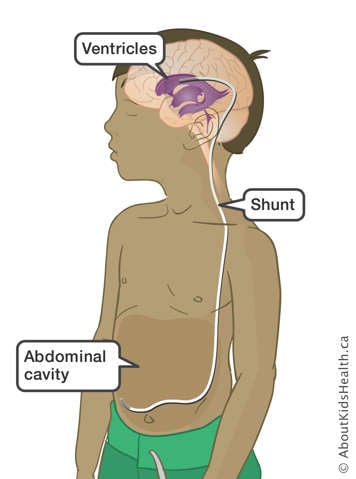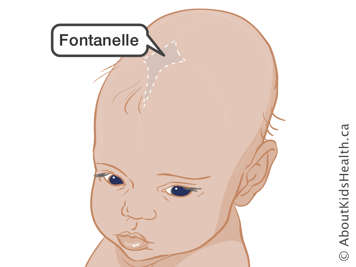Your child may need a ventriculostomy or shunt if they have hydrocephalus. This is the build-up of cerebrospinal fluid (CSF). The ventriculostomy or shunt will help the CSF drain away from the ventricle.
What is hydrocephalus?
Hydrocephalus has also been called "water on the brain." Within the brain, there are hollow chambers called ventricles that produce cerebrospinal fluid (CSF). CSF travels inside the brain and spinal cord on a special pathway. Hydrocephalus occurs when too much CSF gets trapped in this pathway. As a result, CSF builds up, like water at a dam. The ventricles become larger, and pressure inside the head grows. This is hydrocephalus.
Hydrocephalus can be present at birth (congenital). It may also be caused by medical problems such as tumours, cysts, meningitis, or injury to the head.
What is cerebrospinal fluid (CSF)?
CSF is produced in the hollow chambers in the brain called ventricles. It surrounds the brain and spinal cord, and is constantly being produced and absorbed. Some of the functions of CSF are:
- to protect the brain and spinal cord from injury
- to nourish brain cells, which helps with brain functioning
- to carry waste products from brain cells away
CSF travels inside the brain and spinal cord in a special pathway.
What is a ventriculostomy?
An endoscopic third ventriculostomy is a type of surgery done on some children who have hydrocephalus. Your surgeon will tell you if this surgery is possible for your child.
During a third ventriculostomy, the surgeon makes an opening in the floor of the ventricle at the base of the brain. The CSF is then no longer blocked inside the ventricle. Now it can flow in and around the brain as it should.
This means that the child will not need a shunt, but instead will rely on the opening made by the surgeon during surgery. It is still very important to watch your child for signs that the pressure is building up again, as it is possible that the ventriculostomy could fail or become blocked. If any signs come back, it is very important to call your surgeon right away so that your child can be checked.
During the ventriculostomy operation
Your child is brought down to the operating room and is put asleep under general anesthesia. Your child will not feel any pain during the operation. An incision is made on the head. A special scope with a camera on it is passed into the ventricle. The surgeon uses the camera to see the part of the ventricle that needs to be opened up. Once the opening is made, the surgeon will be able to see if the CSF is now flowing outside of the ventricle.
If the surgeon is not able to safely do the ventriculostomy, a shunt will be inserted instead. The incisions are then closed using staples or stitches.
The operation takes between one and two hours.
The main side effect associated with ventriculostomy is that the opening may close or become blocked. This can lead to the recurrence of hydrocephalus. If symptoms of hydrocephalus return, the surgeon may decide to redo the ventriculostomy or consider inserting a shunt instead.
What is a shunt?

The brain is constantly making and reabsorbing cerebrospinal fluid (CSF). Sometimes a tumour blocks the flow of CSF in the hollow spaces in the brain called ventricles. As a result, the CSF builds up like water at a dam and this creates pressure in the brain.
A shunt is a soft flexible tube that acts like a drainpipe. It provides another pathway for CSF to be drained and absorbed away from the brain. One end of the shunt is placed in one ventricle. The shunt is then threaded under the skin, like a tunnel, to another part of the body. Usually it goes to the abdomen, but sometimes it goes to the lungs and rarely to the heart. The CSF is drained and absorbed into the bloodstream.
The shunt tube is attached to a valve. The valve controls the flow of fluid. You can’t see a shunt because it is under the skin, but you can feel the shunt valve and tubing under the skin with your fingers. In thin children you can see parts of the shunt under the skin.
There are many different kinds of shunts. Placing a shunt is a common procedure. The shunt is inserted during a straightforward operation.
Will my child feel any pain with the shunt?
Your child may feel some changes after the shunt is inserted. Most will get better within a few days. Some of these changes are:
- bruises along the upper part of the body (trunk)
- a cut in the scalp and in the abdomen
- redness and bruising from the tunnelling of the shunt
Can my child participate in normal activities?
Children with shunts can take part in most sports and activities. Speak with your child's neurosurgeon if you are unsure about enrolling your child in certain sports.
Caring for the shunt at home
- keep the area where the shunt is inserted clean
- do not put direct pressure on the shunt
- do not put your child’s head underwater in a bath or pool for at least 10 days after the shunt is inserted
- your child can wash her hair with any type of shampoo
Shunt problems
Occasionally, there can be problems with the shunt. For example, it can be blocked or infected, or the tubing may become too short. If a shunt is not working well, your child will need to have an operation to fix the problem. The neurosurgeon will either clear the blockage, or replace the shunt. If the shunt is infected, your child will need to have an external ventricular drain and take antibiotics.
For more information, see the page entitled "Complications From Ventriculostomy and Shunts"
Infections
Infections are usually from your child’s own bacteria, and not from other people who are sick. Contact your child’s treatment team if she has any of these symptoms:
Infants

- a bulge in the soft spot (fontanelle) in the head
- vomiting
- fever
- irritability
- change in appetite
- "sun-set" eyes (you can see the white part of the eye at the top)
- redness or swelling around the shunt tube
- sleepiness
- seizures
- any other concerns you have
Toddlers
- vomiting
- fever
- sleepiness
- irritability
- headaches
- redness or swelling around the shunt tube
- loss of coordination
- seizures
- any other concerns you have
School-aged children
- headaches
- fever
- nausea or vomiting
- sleepiness
- irritability
- loss of coordination
- vision problems
- redness or swelling around the shunt tube
- decline in school performance
- feelings of confusion
- seizures
- any other concerns you have
What is informed choice or informed consent?
Informed choice is the option a person has to allow or not allow something to happen, like diagnostic procedures or treatment, after they have been informed of the benefits and risks of the options involved. If the person agrees, they give informed consent.